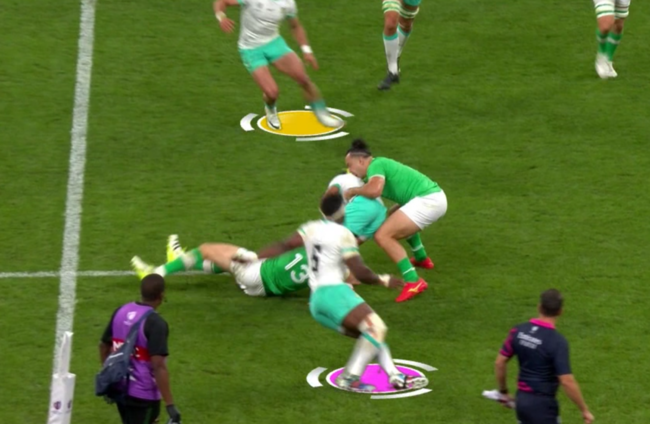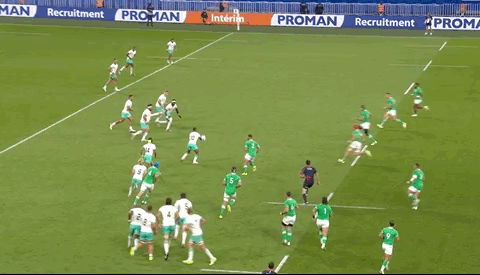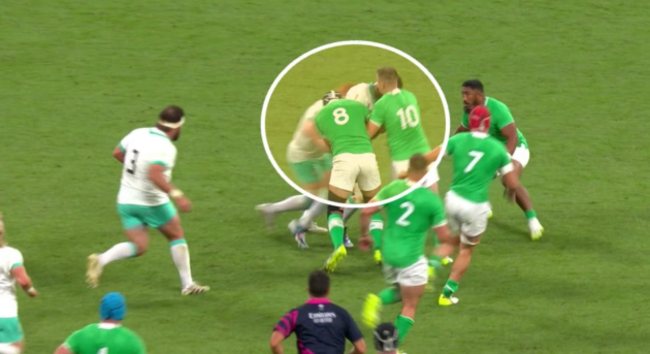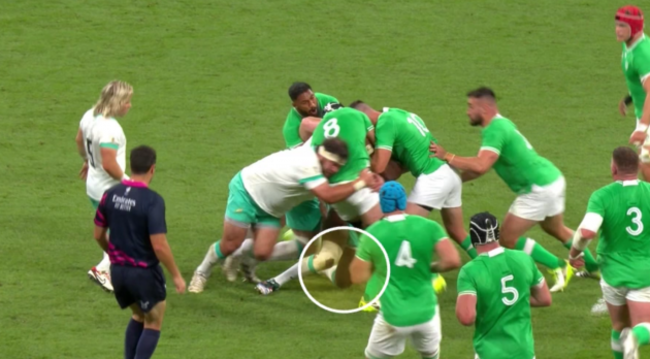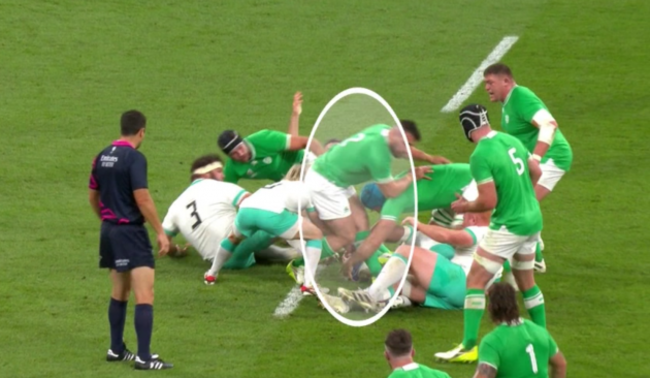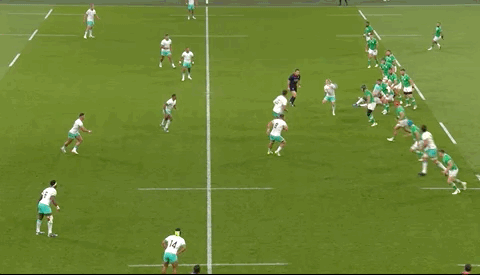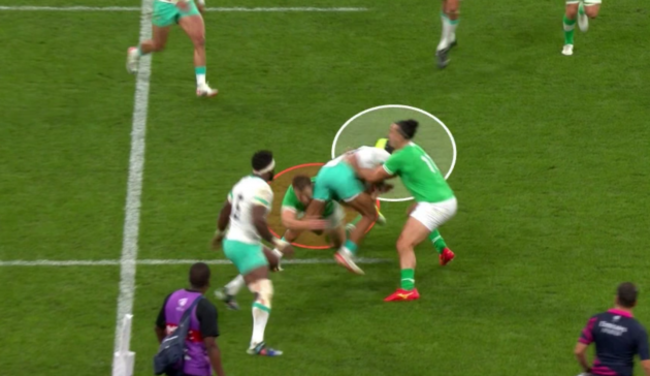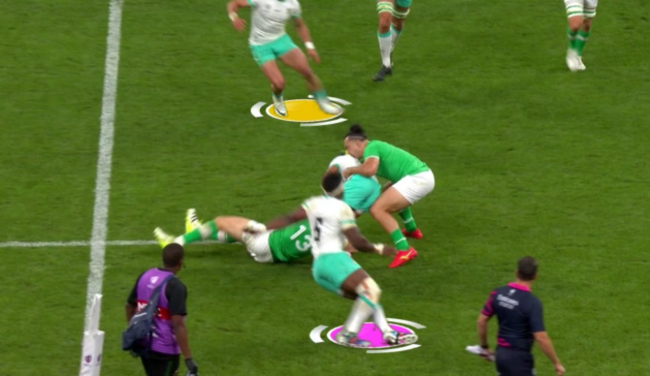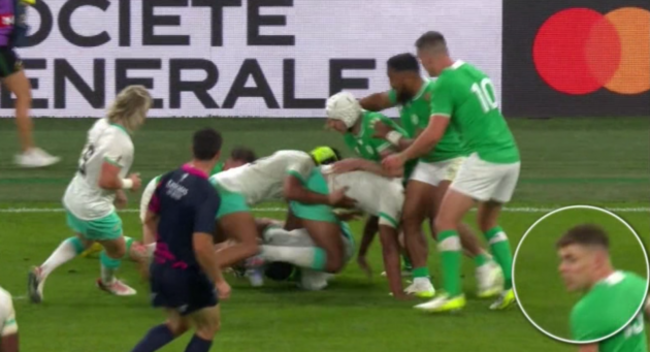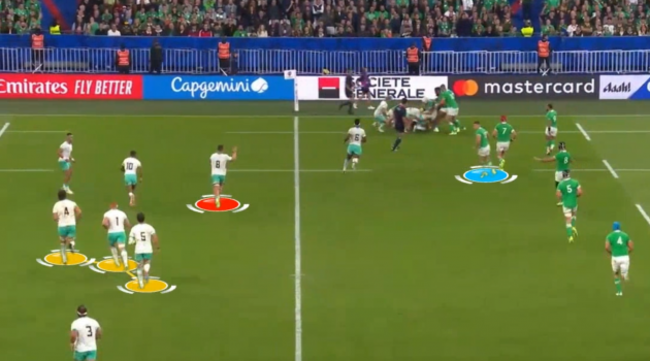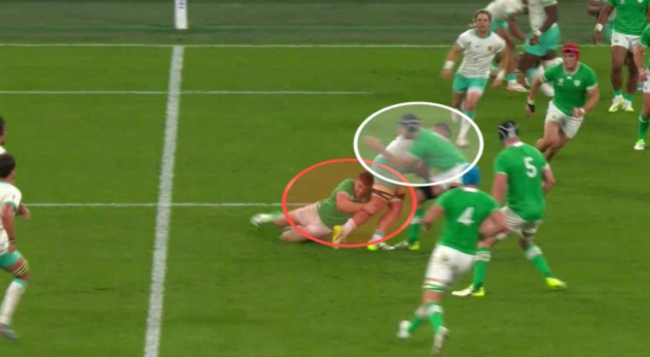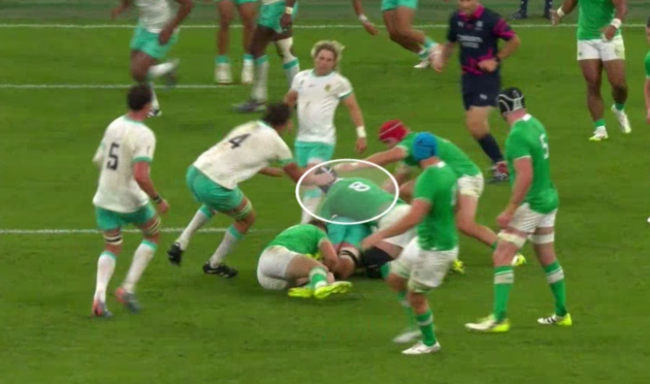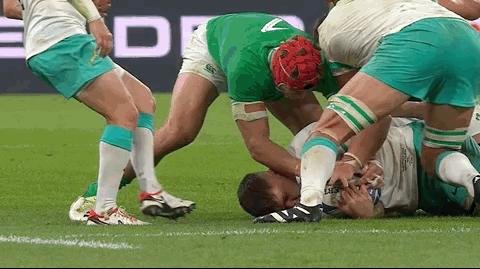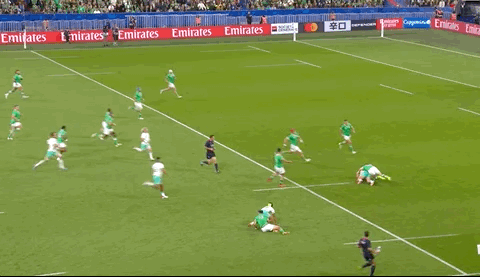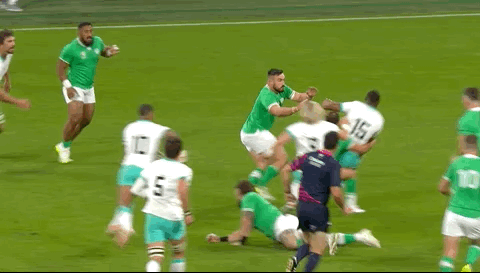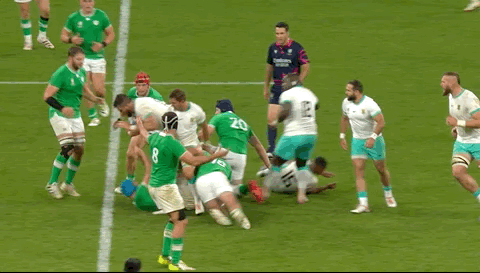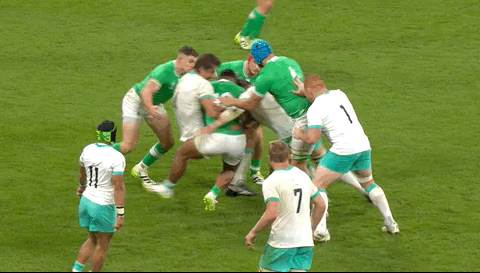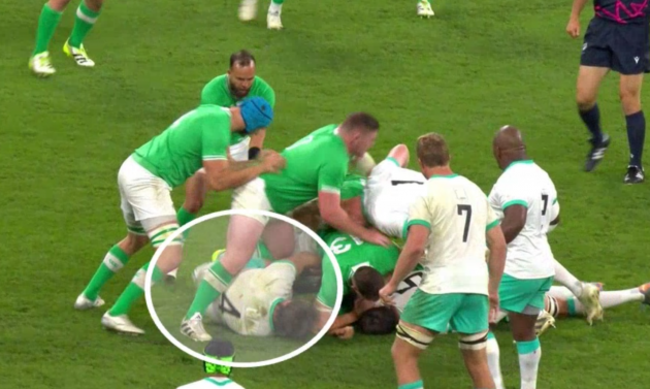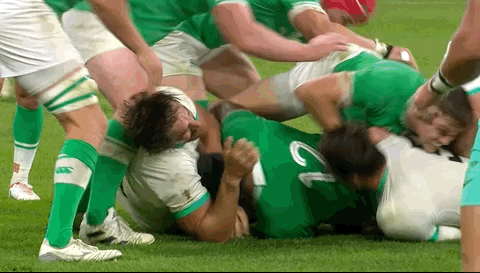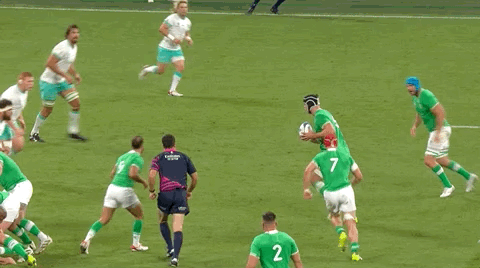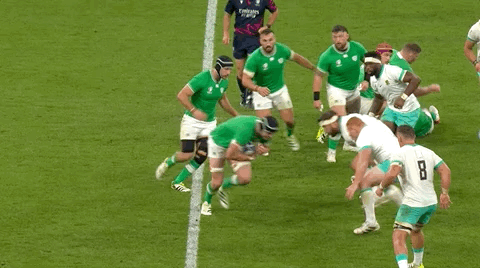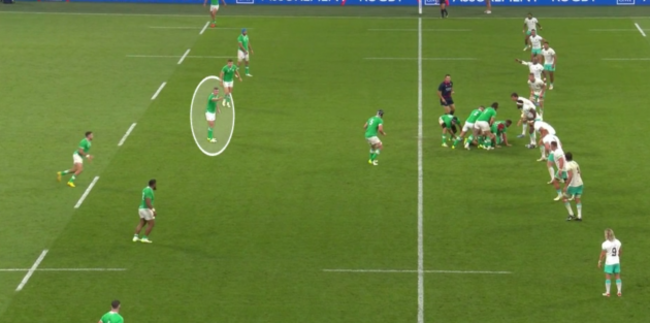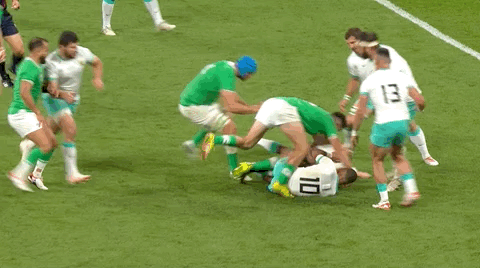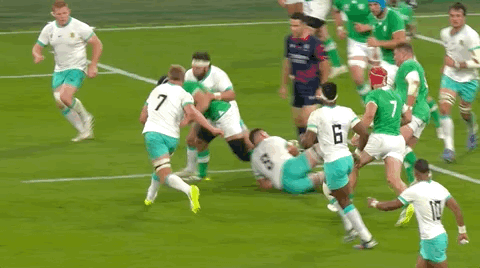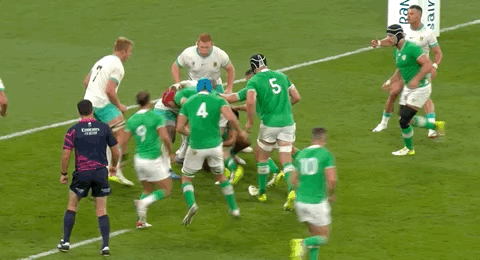ONE OF RUGBY’S key principles is the contest for possession of the ball.
And the breakdown is arguably where this contest is at its most fascinating. Anything can happen once a tackle has been made. It’s such an unpredictable area of the game but such an essential one.
There are few rugby feats as thrilling as earning a breakdown turnover and they’re often remembered as the key moments in games. There’s no denying just how much momentum they can grab.
In that sense, Andy Farrell would have been thrilled to watch his Ireland team earning seven breakdown turnovers as they beat the Springboks in their World Cup pool game last weekend. This was always likely to be an enthralling area of the match.
While Ireland had some big breakdown wins, they were also left with plenty of stuff to improve upon in this area as they move on to their clash with Scotland in two weekends’ time.
Ireland’s first breakdown turnover came from a choke tackle attempt that they were frustrated not to have called as a maul.
As we see below, Siya Kolisi carries off a Springboks lineout and Caelan Doris lands a big shot onto the ball as the first tackler, with Johnny Sexton swiftly joining to further wrap up the ball.
Boks prop Steven Kitshoff joins the contest from behind Kolisi and as soon as that happens, it constitutes a maul.
The laws of the game state that a maul consists of “a ball carrier and at least one player from each team, bound together and on their feet.”
That’s what we have above, but we know that rugby isn’t adjudicated with screenshots and pauses.
In the next second, Kolisi manages to fight down and get his left knee to the ground.
Rugby’s laws say that a tackle occurs when the ball-carrier has “at least one knee on the ground,” so the tacklers have to release when that’s the case.
Having not called a maul at any stage, referee Ben O’Keeffe sees Kolisi’s knee on the ground and roars, “Tackle! Tackle!” as a warning for Sexton, Doris, and Rónan Kelleher, who has also joined, to release Kolisi.
We can see above that Sexton’s not happy and seems to shout something like, “That’s a maul” but he does listen to the referee and releases Kolisi.
The Irish effort isn’t in vain, however. The threat of the choke tackle has been the primary concern of the supporting Boks players, with Kitshoff [blue below] doing his best to drive Kolisi forward, while Frans Malherbe [red] is focused on driving Doris clear of Kolisi, breaking the Irish number eight’s grip on the ball.
As the contest then comes to ground, it means Malherbe and Kitshoff are out of the game.
The ball is exposed and a man like Tadhg Beirne does not need a second invitation to go after it.
Ireland hooker Kelleher is now directly in front of Beirne and there’s a danger of him being penalised for impeding the Springboks’ access to the breakdown.
But Boks scrum-half Faf de Klerk doesn’t attempt to actually hit the breakdown after Beirne has clearly won the race to the ball and got straight onto it.
De Klerk instead stoops as if to pick the ball up and pass it away, meaning O’Keeffe is less inclined to ping Kelleher for where he ends up.
Beirne’s accuracy in getting straight to the ball is rewarded with a clean poach, even if there is immediate frustration as his offload to Doris is knocked on.
It’s an unrewarding end to a good flurry of Irish defence, but they only have to wait another minute for their second breakdown turnover of the night.
This time, it’s wing James Lowe who earns a penalty with his jackal effort.
The opportunity comes from a long, lofted pass from de Klerk that is a little un-Boks. This is actually the kind of pass the South Africa defence loves to see opposition sides throwing.
The time the ball spends hanging in the air allows Garry Ringrose and Lowe to aggressively close down wing Kurt-Lee Arendse and double-tackle him as soon as he has caught de Klerk’s pass.
Ringrose’s tackle selection is excellent as he dips in low to take out Arendse’s legs, stopping him on the spot.
Meanwhile, Lowe goes in high to prevent any offload attempt and to leave himself in position to jackal.
As highlighted below, the nearest Boks support players, Kolisi [pink] and Jesse Kriel [yellow] end up almost ahead of the ball as they have to adjust to Arendse being chopped down so suddenly.
Kolisi actually slips as he turns in, meaning Kriel is the only one close by.
But Lowe has already won this race, staying on his feet and showing a clear release from the tackle.
Crucially, he gets his right hand onto the ball before Kriel makes contact with him, then follows with his left before Eben Etzebeth joins.
Arendse fails to release the ball and O’Keeffe awards Ireland the penalty. It’s superb work from Ringrose and Lowe to punish a poor pass from de Klerk, altough Ireland fail to take advantage as they’re turned over at the breakdown themselves on first phase of the subsequent lineout attack.
It was the last minute of the first half before Ireland’s next turnover at the breakdown and Ringrose was involved again.
The Boks pass all the way to the left edge off a scrum on the right-hand five-metre line and Irish fullback Hugo Keenan makes a good low tackle on Cheslin Kolbe. As Ringrose is reloading into the defensive line, we can see that he’s scanning the Boks attack.
What does Ringrose see?
Ringrose [blue below] sees Boks number eight Jasper Wiese [red] nominating himself to carry off de Klerk.
Wiese is clearly the most genuine option for a carry, given that Kolisi is already so close to the ruck, giving Ringrose an obvious target.
The Ireland centre might also note how far behind the next few Boks forwards [yellow above] are after coming from the scrum. It’s a clear opportunity for Ireland to go after a turnover. Ringrose leads the way.
Ringrose’s linespeed and tackle technique are superb. Again, he dips low to take out Wiese’s legs, while Doris is second into the tackle and hits Wiese’s upper body to get him straight to ground.
Ringrose swings to the far side of the tackle, while Doris shows fine discipline to pull himself back onto Ireland’s side of the tackle – opening the space for Josh van der Flier to jackal but also ensuring that Doris is not penalised for impeding the Boks’ access to the breakdown.
With Etzebeth and then Mostert a hint late arriving, van der Flier wins the race to the ball and shows great accuracy to get onto the ball, as well as strength to absorb the clearout attempt from the Boks second rows.
There is a brief hint of van der Flier’s hand going to ground first but this is a slowed-down replay and he is on the ball in the blink of an eye.
However, Ireland again fail to back up their strong defensive work with a successful attacking outcome from the ensuing lineout in South Africa’s 22.
As Ireland eked their way to victory in the second half, their work at the breakdown was hugely important.
They had a further four turnovers in the closing 15 minutes, with Conor Murray earning a jackal penalty, Doris and Iain Henderson spearheading two superb counter-rucking turnovers, and Aki winning a final breakdown poach in the closing minutes.
The first three of those turnovers are examined in detail in this piece, while Aki’s steal is included in this piece.
Ireland didn’t always have joy at the defensive breakdown last weekend.
We know the Boks can be extremely physical in this area of the game and Ringrose was on the receiving end of one huge clearout early in the game after a superb track-back tackle on Kriel.
De Allende has a big run-up here and a clear target, so he absolutely has the advantage as Ringrose does his best to at least slow the ball down after his tackle.
De Allende hammers his right shoulder into Ringrose’s upper back/shoulder and blasts him away with the kind of venomous clearout the Boks are known for.
Ireland had 70 arrivals at defensive breakdowns in this game, which is a very big number, underlining their intent to disrupt but also the fact that the Boks managed them well on many occasions.
It would also have frustrated Ireland to give up two penalties at the defensive breakdown, with Peter O’Mahony pinged just a few phases after the de Allende clearout.
It’s an easy decision for O’Keeffe as O’Mahony falls to ground after targetting the ball, but it’s also smart play from de Klerk. O’Mahony appears to expect de Klerk to make a clearout attempt on him, so O’Mahony leans his weight beyond the ball. But de Klerk simply backs away, helping O’Mahony to ground.
The Boks kick the opening three points of this game from this penalty.
And then late on in the game, Ireland give up a breakdown penalty that almost results in them allowing the Boks to grab a draw or win.
It’s actually two penalties in quick succession, with the Boks having their choice for kicking to touch. First, hooker Dan Sheehan is called out for hands in the ruck.
It looks like a very tight call as Sheehan tries to get hands on the ball before de Allende makes contact with him, but our view is blocked by the only person whose opinion matters – O’Keeffe.
He has a perfect line of sight and gives the Boks penalty advantage as he says, “Advantage, second man, hands on.”
The Boks continue to play and make progress upfield before a much more obvious breakdown penalty from Ireland.
Henderson’s hands are clearly on the ground first here and then he scoops the ball up after the ruck has formed, falling as he does so. O’Keeffe goes straight to the whistle and gives the Boks their choice of the two penalties.
The Boks kick down the line and nearly score a maul try with the resulting territory. Ireland will be well aware that while they did some excellent defensive breakdown work in this game, there are still bits that need to be sharpened up.
The same applies to the Boks, who won three breakdown turnovers but gave away five penalties at the defensive breakdown. They were pinged four times not rolling clear of the tackle, with Ireland’s subtle dark arts helping on a few occasions.
We get an example below, as Etzebeth gives up a penalty directly from the kick-off of the second half.
Clearly, Etzebeth gets himself into a poor position here and he’s the one who infringes, but Ireland do their best to make sure he’s noticed.
Watch how Furlong helps to pin Etzebeth into the breakdown with his legs, ensuring he can’t just roll away.
Meanwhile, Aki is happy to push the ball directly back into Etzebeth to further highlight his presence.
In reality, Etzebeth is in the space where Furlong would otherwise be able to plant his feet and where Aki could cleanly place the ball, but Ireland were always happy to help to highlight the Boks’ sloppiness in this area.
Ireland won’t have been happy with some of their own work at the attacking breakdown.
They had just 43% quick ball, according to Opta. Quick ball is defined as a breakdown that lasts less than three seconds before the ball is passed away. Quick ball is seen as crucial in attack because the defence has less time to ideally set itself for the next phase.
By way of comparison, Ireland had 90% quick ball against Romania and 68% against Tonga in their other two World Cup games.
In fact, 43% is the lowest percentage of quick ball Ireland have ever had in the Farrell era.
It’s easy to imagine sloppy clearout work as the cause for this but while there might have been small elements of that, the real reason for Ireland’s relatively slow ball was the dominance that South Africa often had in the tackle. Below is a case in point.
Ryan is hammered in a double tackle by Malherbe and Kitshoff, with the Boks clearly winning the collision as the Irish lock is driven backwards.
Van der Flier and Beirne have to retreat to enter the breakdown and that leaves them exposed to the counter-rucking effort of Kolisi and Kitshoff.
While van der Flier and Beirne do recover to clear Kolisi away, it means a seven-second recycle for Ireland. That’s very slow ball.
Funnily enough, Ireland actually make a superb linebreak on the very next phase as Ringrose’s stunning pass finds Keenan, underlining that the Irish attack can cut you open even off slow ball.
They did something similar when Sexton put Aki away down the left touchline later in the first half off slow ball, offering further encouragement that they can create openings despite losing the gainline in the phases before.
That said, Ireland will hope to be more dominant in the collisions in future games, having carried over the gainline just 40% of the time against the Boks. In truth, the South Africans’ defensive might is unrivalled so not many teams will do that to Ireland.
Farrell and co. will also review the three instances in which they were turned over at the breakdown, including one on first phase of a lineout attack, which is highlighted in this piece.
A poor turnover concession early in the second half eventually led to the Boks’ try, via a penalty coming off the woodwork when de Klerk had a long-range kick at goal.
This penalty concession is really about poor decision-making on the back of scrum-half Jamison Gibson-Park getting tangled up amid Boks breakdown pressure a phase earlier.
Gibson-Park is at the bottom of the ruck and Doris stands in at scrum-half with Ryan [red below] the only available forward on his feet close by. We can see Sexton pointing to Ryan, seemingly calling for him to carry and buy Ireland time.
But as Doris begins to pass, Sexton has realised how isolated Ryan is and turns to his right urging Keenan and/or Aki to get in support.
It’s too late as Ryan carries away from the breakdown and his nearest support, Doris, with Kitshoff bringing him to ground, allowing Wiese to pounce for the turnover penalty.
Ireland would have been similarly annoyed with a counter-ruck turnover for the Boks a few minutes later after they worked their way into a promising position just outside the South African 22.
This time, Beirne arrives as a ‘guard’ over the ball but he drops his head, neglecting to scan for threats in front of him, and he’s upright. It’s an invitation to Boks back row Kwagga Smith and he blasts through Beirne, forcing a knock-on just as Gibson-Park attempts to lift the ball.
Those are bits to tidy up but, as ever, there were excellent attacking breakdown efforts in the Irish performance too.
Their players are generally technically proficient at removing jackal threats, as Furlong does here when Pieter-Steph du Toit threatens over the ball.
Furlong dips and accelerates into du Toit, unbalancing him, and then lifts him away to the side, with van der Flier assisting, to leave the ball clear for Gibson-Park.
In the build-up to Mack Hansen’s try, there were some crucial clearouts from Ireland, including the effort below.
It’s du Toit who threatens over the ball again and it takes a collective effort to blast him clear.
Beirne targets du Toit’s left arm to ensure he can’t latch onto the ball, while Kelleher hits the other arm. Kelleher is clearly at a slightly side-on angle here but the positioning of tackler de Allende on the ground blocks his access for a more straight-on clearout. Ryan finishes the clearout by powering in behind Beirne and Kelleher.
Just a phase later, Keenan and Henshaw have to do a job on Boks wing Cheslin Kolbe to ensure he can’t kill the attack.
Watch how Kolbe slides in from behind to jackal over Sexton.
Keenan connects with Kolbe first but then his legs are taken out by tackler Kriel getting up, ensuring he is depowered. That means Henshaw’s arrival is crucial as he gets a second hit onto Kolbe and then grapples to clear his arms away from the ball.
Ireland manage to recycle and score on the next phase.
The breakdown will never be a perfect science. Every single breakdown is a new contest with its own circumstances and quirks.
That’s what makes it all so engrossing. Ireland generally come out with more good than bad, but they’ll keep striving for better.
